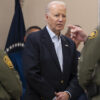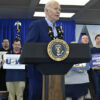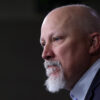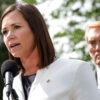Masks have become a flashpoint in the global response to COVID-19. But what the corporate media doesn’t want you to know is: They don’t work.
“I think it’s one of the most consistent things we can see across locations, is that there’s been really no impact from masking,” Ian Miller, the author of the new book “Unmasked: The Global Failure of COVID Mask Mandates,” says.
“The data’s publicly accessible. It’s all from [the Centers for Disease Control and Prevention] or The New York Times or Johns Hopkins [University] or the World Health Organization. … [People] are getting their information exclusively from either the experts like [Dr.] Anthony Fauci, who have been provably wrong over and over again, or from mainstream media outlets that have just done a really poor job of covering this and presenting the data.”
Miller joins the show to discuss why masks and mask mandates didn’t work, and in fact, might have made things worse.
We also cover these stories:
- President Joe Biden says he still wants diplomacy to prevail in the Ukraine-Russia crisis, but adds that the U.S. is prepared to impose severe sanctions against Russia if it invades its neighbor.
- Former Hillary Clinton campaign lawyer Michael Sussmann demands that the “factual background” section in special counsel John Durham’s most recent filing be removed from the record.
- The Senate votes 50-46 to confirm Robert Califf as commissioner of the Food and Drug Administration.
Listen to the podcast below or read the lightly edited transcript.
Doug Blair: My guest today is Ian Miller, author of the new book “Unmasked: The Global Failure of COVID Mask Mandates,” available now wherever books are sold. Ian, welcome to the show.
Ian Miller: Well, thanks very much for having me on.
Blair: What an important topic to talk about. Masks are all over the news these days, but let’s start by getting our bearings here. How effective have mask mandates been during this pandemic?
Miller: The short answer is completely ineffective. The long answer is a lot more complicated than that, and that’s obviously what I go into in the book.
But one of the most consistent things that you can look at with COVID, and there’s not very many consistent things, but one of the most consistent is you can go and look at states, at cities, at counties, at countries, compare different locations and nearly everywhere you go, there is no effect from putting in a mask mandate and having good outcomes—whether that’s in a couple of weeks generally or down the road as well.
And there’s a lot of great examples of areas that were specifically credited with wearing masks that saw their numbers immediately arise afterward. Just off the top of my head, one example is Israel, where there was a Wall Street Journal article in November of 2020 saying that masks had brought their curve down, brought the wave down, and then immediately afterward cases broke all the records again.
And anyway, so I think it’s one of the most consistent things we can see across locations, is that there’s been really no impact from masking.
Blair: So the efficacy of masks is shown by the data that we have to not really pan out?
Miller: Yeah, the data on it. And to be fair, this is exactly what we should have expected—and I go into this in the book as well—because all of the studies, the scientific studies on masks to prevent respiratory viruses pre-COVID, all said this, that it wouldn’t really work. So it shouldn’t have been surprising that it hasn’t worked.
But I think there’s been a dramatic shift in terms of the political climate in the last couple of years. And unfortunately, masks became this politicized issue.
But yeah, all the data that we’ve seen from all over the world has been very consistent that there’s no impact from it.
Blair: I do want to go into the politicization of masks because that seems to be the more pressing topic. But the new guidance from the [Centers for Disease Control and Prevention] indicates that cloth masks aren’t very useful, but maybe N95s are. Is that an honest statement, that certain masks are better than other masks?
Miller: In theory, N95s would be better. In practice, the actual N95 respirators, which are the ones that are being distributed right now, require fit testing in order to work properly. So it’s not just like, oh, you put on an N95 and you’re protected forever. It needs to be fitted properly to your face.
For example, if you have facial hair, it’s going to be very hard to get that to fit properly. They’re also incredibly uncomfortable to wear for any extended period of time and they need to be, obviously, discarded after individual uses or every couple or two uses and people don’t use it that way.
So in theory, if you were using N95s properly and they were fit tested and they were disposed of after every use, or maybe one or two uses, it could provide some protection, but in practice, that’s not how reality works, so it doesn’t really matter.
And we actually have a real-world example of this already. For example, in Germany, there are a couple states that have mandated N95-level masks and a number of other states haven’t. And the states that have the N95 mandates have actually done worse.
So in reality, we’ve already tried to do this experiment and it didn’t work, which is unsurprising given how it’s impossible to use these properly.
Blair: Now, Ian, I’m going to ask a very difficult question here. As a bearded man myself, would I just be better off not wearing a mask at all?
Miller: Yeah, there’s no protection from it. So yes, you would be better off not wearing a mask at all.
It’s one of those things where this was established science for a very long period of time, which is why for every pandemic that happened throughout the 20th century and after the 1918 pandemic, obviously, but there were other pandemics that happened in the 20th century and masking was never recommended.
All the evidence showed it wouldn’t be effective in large part due to aerosol transmission. Aerosols just go right through mask fibers and once they’re in the air, if you’re in the room and you’re susceptible, you’re very likely going to get infected.
And aerosol transmission has become accepted as the dominant route for COVID and on studies—I referenced one in the book from the United Kingdom where their health agency specifically says masks don’t stop aerosols.
So nothing about that changed from 2018, 2019, into 2020. That never changed. Masks didn’t suddenly become better at stopping aerosols.
So you’re not really getting any protection from wearing it. It’s not helping prevent the transmission of it because it’s just the aerosols just go right through and they get into the air. And that’s it.
Blair: Now, we approached this topic at the beginning, that masks have become a political statement. I remember a tweet by David Hogg a couple of months ago where he said, “I don’t know about these masks, but I don’t want people to think I’m some kind of Republican or conservative so I’m just going to keep wearing it.” That sort of indicated where we’re at, that masks are now a statement of where your political allegiances lie. How did we get to that point?
Miller: It’s a great question. I think it stems from a broader societal issue where I like to call it the “believe in science” crowd.
I’m sure everybody’s seen these yard signs that people put up in front of their homes, like, “In this house, we believe in science.” And it’s become this mantra of allegiance to the correct set of ideologies and opinions that you’re supposed to have in modern society.
I think there’s this universal trust among a large subset of the population and anybody that considers themselves an expert or a scientist and who appears on TV with a credential that says that they’re a scientist.
And it’s led down this destructive path during COVID where the people who are supposed to be experts, who are supposed to be scientists have just been completely wrong about almost everything during the entirety of the pandemic, but they still get this loyalty and this allegiance because it’s all connected to this whole, “Well, they’re the science.”
Literally Anthony Fauci [director of the National Institute of Allergy and Infectious Diseases] says, “I am science. I am representing science.” So if you claim to be representing science and you have a yard sign in front of your house that says, “I believe in science,” well, you have to follow along with whatever Anthony Fauci says.
And I think that that’s what we’ve seen over the last couple of years. And there really isn’t any evidence or data behind it. It’s just this adherence to an overarching set of political principles, unfortunately.
Blair: To follow up on that, is that why we still have these mask mandates in place? Is the reason why I can’t go into a grocery store without putting a piece of cloth on my face because there’s this political messaging? It seems like we have all this data, I don’t understand how we can have that data and then still have these—it’s almost like theater.
Miller: Yeah, well, you’ve hit a lot of major issues there and there’s a couple different ways to answer that.
I think one of the biggest problems is the lack of media coverage. And in the book I do this—and this is what I’ve been doing on Twitter and I write a Substack as well and all these things—which is just showing, OK, we put the mask mandate in here at this particular area at this time. If it was so effective, what would you expect to see?
Or you can compare two states that are next to each other and say, “This state mandated masks and this one didn’t, which one would you think would do better?” If I don’t put a label on for which state is which, could you guess which state had the mask mandate and which didn’t? And if you can’t, well, that kind of destroys the whole point of putting in a mask mandate, right? Because if the mask mandate is so ineffective that you can’t tell the difference, why are you doing it?
So the point of that is that it’s very simple to do this. It’s not hard. The data’s publicly accessible, it’s all from CDC or The New York Times or Johns Hopkins or World Health Organization. And yet nobody in the media is doing this, nobody on CNN or [The] New York Times or Washington Post, these mainstream media outlets aren’t doing this. They don’t go through and show people what the results have been.
I think that’s one of the biggest problems, is that the people who make decisions—especially in cities like Washington, D.C.; Los Angeles; New York—they are getting their information exclusively from either the experts like Anthony Fauci, who have been provably wrong over and over again, or from mainstream media outlets that have just done a really poor job of covering this and presenting the data.
So I think there’s a lot of ignorance. I think there’s a lot of purposeful hiding of the data because I’m sure they all know it, but it’s not fitting with what they want to do. And I think they realize that these measures are in large part fairly popular with their base, with the “believe in science” crowd. People want to feel like they are contributing and that it gives them this superiority over those who refuse to wear a mask, for example.
Blair: Now, you mentioned that their base is very on board with the idea of mask mandates. And I have friends who are liberals who feel more comfortable when mask mandates are in place and even if they’re allowed to wear a mask, it’s not like they’re forced to, they still choose to do it. How does the general public feel about mask mandates and things like that?
Miller: I think over time, the percentages have really changed. I think, hopefully, there’s been more willingness to engage in these conversations. And we’ve seen a little bit of the breaking of the dam.
A couple weeks ago, a CNN medical contributor who has really done a terrible job throughout COVID … finally said cloth masks are essentially facial decorations.
So I think when people hear that, they’re saying to themselves, “Well, wait a second, for a year and a half, I was told this was the most important thing to do, that I was going to be killing an elderly family member if I didn’t wear a mask.” And you see people getting yelled at and escorted out of businesses and all these things for not wearing a cloth mask. And now, “Oh, wait a second, they were useless and they always have been.”
So hopefully this conversation is shifting. …
I think there’s a large percentage of people, maybe half, that just kind of comply because they don’t want to get in trouble and there’s maybe 20% to 30% that really believe it doesn’t work and know it doesn’t work and then there’s the other side that maybe 20% or whatever it is that are very dedicated to it.
And unfortunately, that 20% that are dedicated to it are making public policy or impacting public policy and they’re the ones who corporations and politicians want to appeal to. They don’t care about offending people who don’t want to wear a mask, they only care about offending those who feel scared and only feel safe if they have a mask on or if everybody else around them does, too.
Blair: You talked about this point a little bit where the rhetoric we’ve gotten has shifted from, “Masks don’t work, don’t use them,” to, “Masks are mandatory, you have to wear them to go inside,” to, “Cloth masks don’t work, we’re going to use these masks.”
It feels like there’s a constantly shifting treadmill of information about how masks work. How does this shift in guidance and change in guidance affect trust in the public health authorities that are supposed to be keeping us safe?
Miller: That’s a great question. That’s a really good question. I think it should be destroying it. I think it has for a lot of people.
I think a lot of people have started to realize that … it’s not about “following the science,” as they like to say, it’s just that they really don’t have a lot of ideas [about] what to do and so they’ve just thrown everything at the wall to see what sticks. And unfortunately, none of it sticks because it’s basically impossible to stop the spread of a highly infectious respiratory virus.
And it’s an unfortunate thing because in a lot of ways, it is very important to have trust in public health and have trust in science and expertise but it has to be based on evidence and data and not just based off of wishful thinking and “we have to do something because we need to be seen as doing something.”
I think the trust problem has gotten progressively worse and I keep feeling like every moment when you go from, “Wear anything, wear a cloth mask,” to, “Oh, actually, now you need two masks,” “Now two masks isn’t good enough, you need a surgical and an N95” … it feels like, to use an entertainment term, jumping the shark every time. …
As the guidance gets progressively less evidence-based and more just theoretical of, “Two masks makes more sense, so do that”—that’s basically what Fauci said—I think that it really has diminished trust in public health and it’s going to have long-reaching consequences down the road in terms of other illnesses and diseases where people don’t take their advice anymore because they don’t trust them.
Blair: I’m really glad you mentioned the two masks instead of one mask because I remember very distinctly when that guidance came out and just this visceral reaction of, “Really? That seems so surreal to me.”
And we were talking a little bit before the show about my home state of Oregon that used to have an outdoor mask mandate long after the science was settled that this thing doesn’t really spread around outside all that much.
Does your book go into some other examples of, “We’re just doing this because it’s something,” other ridiculous mask mandates?
Miller: The outdoor mandates I cover a lot. Los Angeles has had outdoor mask mandates for a long time. Believe it or not, they still have an outdoor mask mandate for large events where anything more than 5,000 people still requires outdoor masking. So yeah, I go through a lot of these examples of areas.
Just a random example was Chile, the country of Chile, where the president of the country was fined, I think it was something like $5,000 for taking a selfie on the beach without a mask. So a person ran up to him, he’s on the beach, and they take a picture together and he’s maskless, and he was fined for that.
And that was the president of the country. And it was meant to show, “This is how seriously we’re taking this. Masks are so important that everybody [should] be wearing them on a beach, outside, that we’re going to fine the president of the country to show nobody’s above this mask law.”
And then of course, cases in Chile go skyrocketing up just a couple weeks later, a couple months later.
Anyway, yeah, there’s a lot of examples of the precautionary principle run wild and that’s really the biggest issue, is that it was all based off of this theory that it might work so we have to pretend like it does work and mandate it and use it harder. And the less it works, the worse our policies get. And that’s been a very consistent, infuriating pattern, I think, throughout the pandemic.
Blair: It’s fascinating that you mentioned that the president of Chile was fined because I’m looking back to America and, of course, in the news now is [California Gov.] Gavin Newsom and [Los Angeles Mayor] Eric Garcetti, who were photographed maskless. Eric Garcetti, apparently, tried to justify it by saying he was holding his breath when he removed his mask—so that’s impressive.
I guess my question is, why is it acceptable for, it almost feels like the political class at times to not mask up whereas it almost feels like there’s this different set of requirements for other people to mask up?
Miller: Right. And there’s been a ton of famous, infamous images where, for example, I think it was a [House Speaker] Nancy Pelosi fundraiser where there were a bunch of wealthy elite people that were donating to her campaign and all of the people serving them food were all masked up and they’re sitting there completely unmasked.
And this is still a problem in a lot of areas that don’t have mask mandates, where you see employees have to wear masks and those people being served don’t.
It’s become fairly obvious that a lot of these politicians don’t actually take these rules very seriously. … They really don’t think that they matter very much, but they view it, I think, as a tool to show people we’re still in a pandemic and you need to be taking this seriously, and you should be scared.
It is really impressive how often the people that push these rules the hardest are the most willing to not comply with their own mandates. Obviously, Gavin Newsom had this happen in, I think it was 2020 when he had that dinner at the Napa Valley restaurant and was photographed without a mask on standing up and talking to people.
We’ve seen that happen now with the U.K. where [Prime Minister] Boris Johnson and all of those people have been in hot water now because of all the parties they were supposedly having during lockdowns and people couldn’t go to funerals or have weddings or anything.
So it’s been a very consistent part of this. And if you take them at their word, at the logical conclusion of this, it’s pretty obvious that they don’t take this very seriously and that they don’t really view these measures as being that important, that it’s much more about encouraging compliance in others with what they say and not with what they do.
So I hope that that continues to erode trust in these politicians as well because they definitely deserve it.
Blair: We’ve mentioned a couple of foreign examples of mask shenanigans, if you will. What are other countries around the world doing regarding masks? Do we see that a lot of countries still have mandates in place? Do we see that they are more strict than America, less strict than America? What are we seeing abroad?
Miller: It’s widely varied. If you look at Europe, for example, I believe Spain and Italy and a couple other countries brought back outdoor masks as well in this latest winter surge. And obviously, there’s been no impact from that. The cases have skyrocketed anyway.
It’s very different—you can go and look at Wales and Scotland and England, for example, those are great examples. They’re all so close and they’ve had different rules at different times and yet the numbers go up and down regardless.
So, Wales has had a consecutive mask mandate, it never ended, whereas England had a mask mandate that ended earlier on and the numbers were the same anyway and England, I think, did better at certain times.
So again, it’s a very similar pattern to hear what we see in the United States where you can compare areas with and without mandates and the areas without mandates are often doing better.
Sweden is the gold standard example where hardly anybody has used masks there at any point. And I think in the book I reference Germany and Sweden, where you have Sweden with hardly anybody wearing masks, is like 2% compliance, and Germany with 90% compliance and they’re very close to each other and Germany had a higher death rate for basically all of 2021 and into 2022 than Sweden.
And Sweden’s numbers now, cumulatively, I think, are around the 60th in the world in death rate. So it’s very average and they’ve outperformed the rest of the European Union.
So the rules are different depending on the country and yet the results have been fairly consistent that the areas with the least amount of masking are either doing the same or better.
Blair: One of the new battlefields regarding mask mandates is in the field of education. We’re talking about whether or not kids should be masked in schools. How do masks impact a child’s development? Do we have any data that indicates these masks are causing problems or do they not do anything at all? Where are we at with masks and children?
Miller: Hopefully we’re making progress on that. I think there was this campaign started called “The Urgency of Normal,” I think is what it was, where a lot of doctors, like over 800, have now started pushing for kids to be able to go to school without masks, with a sense of normalcy.
There was a study I came across and I can’t remember the exact numbers, I think it was something like a 360% increase in development issues among children due to masking … communication problems. And obviously, it makes sense.
You put 2- or 3-year-olds in a mask, they’re not going to handle that particularly well, they don’t know what it is. They don’t really know how to handle it. Two-year-olds don’t know how to take care of a mask properly. If it was ever going to be effective, it has to be handled and taken care of properly. Obviously, kids are not able to do that.
And it’s just a complete farce that we’re pushing this on to kids when you see these photos of politicians standing in the back row maskless and there are kids in front of them all masked up. It’s painful to see it.
There’s demonstrable side effects, demonstrable harms to it. And I did this recently where I compared all the states that have forced masking in schools and those that are optional or have no masking in schools and just like everywhere else, the states that have the forced masking have a higher case rate than those without it.
So there’s no impact to it, there’s no benefit to it. It has only harms. And just in the purest, logistical form, it makes absolutely no sense because these kids can never hope to take care of a mask properly in a school environment. It’s completely absurd.
Blair: Are we alone on the world stage in masking our children?
Miller: I believe we’re the worst in terms of masking young kids. I know a lot of European countries never masked kids under 12, for example. A lot of other countries are anything under 6, anyone under 6 they don’t require masks. Going down to 2 is pretty much the worst that it is across the international stage, as far as I can tell.
Blair: That’s something that happens here in D.C. I was going to a Smithsonian museum and they had … a sign that said you had to mask a child as young as 2 years old. Where does that come from? Is there a justification that they’re using for this? Is there data that we can look to and say, “Well, we don’t agree with the data, but this is what they’re referencing”?
Miller: The problem with the data is that a lot of what the CDC has put out has been really, really bad and misleading. I wrote a whole chapter on it in the book where I go through a couple of the studies they use to try to justify mask mandates in Arizona and Kansas, for example. And it’s really bad. …
There’s been a lot more willingness to speak out on this recently with other doctors and scientists and experts. Vinay Prasad from San Francisco has done a great job pointing out a lot of the flaws in the CDC’s data. So whatever they would try to put out to justify it is very often untrustworthy and very methodology-flawed.
I haven’t seen any good reason to justify masking 2-year-olds. I haven’t seen them come up with anything that has shown why 2-year-olds, specifically 2- to 5-year-olds, could ever be justified to use masking.
Again, I think it’s just the precautionary principle run wild. I think there’s a lot of irrational fear out there. … I think it’s probably also some deference to organizations like teachers unions and stuff that are with very young kids that are in school and teachers unions have pushed very hard for forced masking. And a lot of it just comes back to that whole problem of believing in science and all that comes along with that.
Blair: I think a lot of people are concerned when they look at these mask mandates that they don’t really seem to have an off-ramp.
So going back to Oregon, again, the Oregon Health Authority is trying to make indoor mask mandates permanent, [with] the justification that, “Oh, we can get to it later. And if, you know, things change, we can remove it.” But it’s scary that we’re looking at laws that are being put into place that are codifying mask mandates into law with no metric set to say, “We’re going to remove it at this point.” Are these fears of permanent mandates justified?
Miller: I think so. And that’s my goal, is to try to completely destroy the entire rationale behind masking being beneficial at all, because that’s the only way that you can permanently end this.
I’ve tried to put it like, once you committed to the lie that masks work, you can never let them go because there will always be respiratory virus transmission. Everybody acknowledges this now, COVID is never going away. It’s never going to be eradicated. The flu has, obviously, never been eradicated and it’s never going away. So there will always be now this excuse to bring back mask mandates.
Even if you say, “OK, well, in the summer, we’re not going to do it, but as soon as the numbers go up in the winter, we’ve got to bring mask mandates in,” even though it hasn’t worked. Every winter that we’ve been dealing with COVID, there’s always going to be this underlying assumption that masks work and that’s why we have to bring them back.
A good example, too, is Montgomery County, Maryland, just outside of D.C., where they had set a target of, like, “Oh, if we get 85% of the population vaccinated, we’ll lift the mask mandates.” And they basically did that. And now they’re discussing making it permanent there, too.
So it just kind of shows you, if you believe that masks work, you can never stop believing it because they don’t and so the numbers will always be there to justify the masking. So unless you destroy the entire foundation of masking as a potential intervention … there’s always going to be this fear that you could bring masking back whenever you feel like it.
Blair: All right, so we’ve had a very long conversation about masks, their efficacy, and what our neighbors on the world stage are doing. What [should] average Americans, you and me, people out on the street, what should we be doing regarding masks? Is it time to ditch them? Is it time to say, “No more”? What should average Americans do regarding masks?
Miller: The only thing I think that will have a really significant impact is voting out the people that have been forcing masking.
It’s clear that you see these videos of parents going to school boards. That’s one of the clearest examples of local people being able to directly have a conversation with those that are forcing masking in schools, for example, and it just doesn’t seem to help very much. You see all these videos, you go to the school boards, and then they keep the mask mandate or they make it worse or they punish kids.
In Virginia right now, you see these school boards are openly defying an executive order. It’s insane that they’re just getting away with saying, “We’re just not going to listen. We don’t care and we’re going to punish kids who come to school without a mask on.”
So the only thing that will really have a significant impact, I think, is voting out the politicians that have brought this in in the first place.
My hope is that there will be a change in federal leadership through Congress, through the presidency at some point in the next couple of years where you can replace the people in charge right now that are pushing this and that are recommending it and continuing to recommend it despite all of the evidence.
Really a change in the entire political leadership is going to have to happen here because people like Rochelle Walensky from the CDC and Anthony Fauci are never going to come out and say, “Actually, we got this wrong, masks never worked. We can all remove the mask now permanently.” They’re never going to admit that.
So you’re going to have to have an entirely different group of people come in and change the conversation, change their recommendations, and not give these local areas excuses to continue mandating them. So that’s my sense, is it’s really going to come down to voting.
Blair: Well, we’re going to wrap there, but that was Ian Miller, author of the new book “Unmasked: The Global Failure of COVID Mask Mandates,” available now wherever books are sold. Ian, phenomenal conversation. Really appreciate you coming on the show.
Miller: Oh, thank you so much for having me on.
Have an opinion about this article? To sound off, please email letters@DailySignal.com and we’ll consider publishing your edited remarks in our regular “We Hear You” feature. Remember to include the URL or headline of the article plus your name and town and/or state.

























